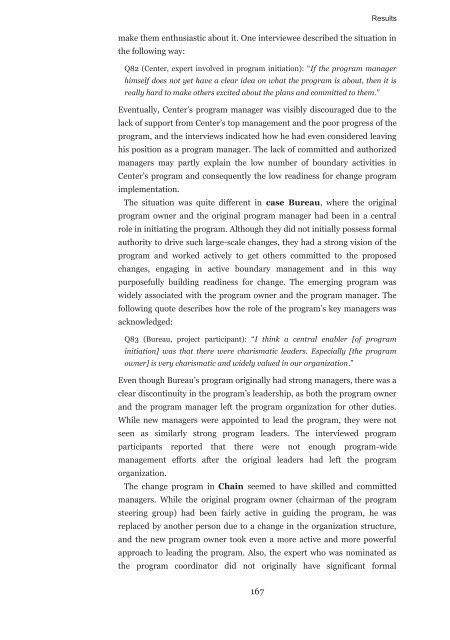Boundary activities and readiness for ... - Projekti-Instituutti
Boundary activities and readiness for ... - Projekti-Instituutti
Boundary activities and readiness for ... - Projekti-Instituutti
Create successful ePaper yourself
Turn your PDF publications into a flip-book with our unique Google optimized e-Paper software.
Results<br />
make them enthusiastic about it. One interviewee described the situation in<br />
the following way:<br />
Q82 (Center, expert involved in program initiation): “If the program manager<br />
himself does not yet have a clear idea on what the program is about, then it is<br />
really hard to make others excited about the plans <strong>and</strong> committed to them.”<br />
Eventually, Center’s program manager was visibly discouraged due to the<br />
lack of support from Center’s top management <strong>and</strong> the poor progress of the<br />
program, <strong>and</strong> the interviews indicated how he had even considered leaving<br />
his position as a program manager. The lack of committed <strong>and</strong> authorized<br />
managers may partly explain the low number of boundary <strong>activities</strong> in<br />
Center’s program <strong>and</strong> consequently the low <strong>readiness</strong> <strong>for</strong> change program<br />
implementation.<br />
The situation was quite different in case Bureau, where the original<br />
program owner <strong>and</strong> the original program manager had been in a central<br />
role in initiating the program. Although they did not initially possess <strong>for</strong>mal<br />
authority to drive such large-scale changes, they had a strong vision of the<br />
program <strong>and</strong> worked actively to get others committed to the proposed<br />
changes, engaging in active boundary management <strong>and</strong> in this way<br />
purposefully building <strong>readiness</strong> <strong>for</strong> change. The emerging program was<br />
widely associated with the program owner <strong>and</strong> the program manager. The<br />
following quote describes how the role of the program’s key managers was<br />
acknowledged:<br />
Q83 (Bureau, project participant): “I think a central enabler [of program<br />
initiation] was that there were charismatic leaders. Especially [the program<br />
owner] is very charismatic <strong>and</strong> widely valued in our organization.”<br />
Even though Bureau’s program originally had strong managers, there was a<br />
clear discontinuity in the program’s leadership, as both the program owner<br />
<strong>and</strong> the program manager left the program organization <strong>for</strong> other duties.<br />
While new managers were appointed to lead the program, they were not<br />
seen as similarly strong program leaders. The interviewed program<br />
participants reported that there were not enough program-wide<br />
management ef<strong>for</strong>ts after the original leaders had left the program<br />
organization.<br />
The change program in Chain seemed to have skilled <strong>and</strong> committed<br />
managers. While the original program owner (chairman of the program<br />
steering group) had been fairly active in guiding the program, he was<br />
replaced by another person due to a change in the organization structure,<br />
<strong>and</strong> the new program owner took even a more active <strong>and</strong> more powerful<br />
approach to leading the program. Also, the expert who was nominated as<br />
the program coordinator did not originally have significant <strong>for</strong>mal<br />
167









